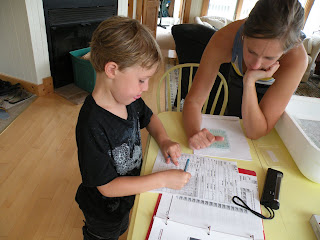 Interested in having a Master Steward out to your property?
Interested in having a Master Steward out to your property?Tuesday, August 24, 2010
Stewards of the land
 Interested in having a Master Steward out to your property?
Interested in having a Master Steward out to your property?Thursday, August 19, 2010
A beautiful beaver pond
I wanted to continue with the post from last week and show you some pictures from a recent Stewardship Program visit. These landowners are enthusiastic about what they are learing from the active beavers on their property.
Added benefit of letting nature do its' thing: a lot of other wildlife that uses this area! The owners love sitting in the gazebo by the pond at dusk watching all the activities. They are inspired by watching the pond and the wildlife it attracts. They have seen deer being chased by coyotes then seen the coyotes playing at the side of the property. In the winter their observations include a moose and her calf on the pond.
It just goes to show the different approaches that can be taken on different properties. A perceived problem can actually be a fantastic learning opportunity- and it is beautiful!
Friday, August 13, 2010
The Good and Bad of Beavers

Beavers can sometimes be a nuissance by initiating flooding in fields and forests, washing out roads and killing trees. However, they also play an important role in our ecosystem by creating wetland habitat for many animals, birds and insects.
The photos in this post illustrate damage from a beaver and one solution the landowner is trying out to keep the beaver from taking any more trees in this marshy area. At the end of the post I will write more about other solutions and sources for more information.

{The landowners noticed the grasses and reeds had been stomped down where the beaver made a path to some juicy birch trees. He took 3 small birch before the landowners decided to take action}
 {There are several trees in the area of the first 3 birches. Some of them are conifers which the bever is unlikely to take. There are 2 basswoods and 1 birch which the landowners decided to protect the trees with cages. The bottom is held doen with rocks and the wire extends 2 feet up the tree to deter the beaver from starting to chew.}
{There are several trees in the area of the first 3 birches. Some of them are conifers which the bever is unlikely to take. There are 2 basswoods and 1 birch which the landowners decided to protect the trees with cages. The bottom is held doen with rocks and the wire extends 2 feet up the tree to deter the beaver from starting to chew.}
- On the Living Edge: Your handbook for Waterfront Living (an amazing resource book available at the Muskoka Heritage Foundation for $20)
- Peterson Field Guides: Mammals
- Muskoka Water Web: The importance of wetlands
- Solutions to Beaver/Human Confilcts (including a photo of the beaver baffler)
What are your tactics for dealing with beaver on your land?
Wednesday, August 4, 2010
Water Quality in Muskoka


{Drew and I take a look at the coli plates in the incubator. They sepnd 24 hours there before analysis. There is one plate for each of the 6 sample locations from one area of the lake}
{Part of the analysis includes checking for e-coli using a uv light. The e-coli are florescent and we count how many wells in the plate are glowing}
{We also count how many wells have turned blue. This indicates how many coliform are present in that particular sample}
{We record the data and submit it to MLA in order to monitor long term trends. Included in the program is collecting and analysis of e-coli, total coliform levels, total phosphorus concentration, turbidity, and temperature of the lakes}
There are other very comprehensive programs and resources related to water in Muskoka:
- Muskoka Watershed Council: champions watershed health.
- Muskoka Water Web: resources, lake data sheets, District of Muskoka water quality monitoring program, how to protect the water.
- 2010 Freshwater Summit: resources, speaker presentations and videos, petition, communiqués from the Summit and Youth Summit.
- District Municipality of Muskoka: overview and links to year-end reports.
- The Resources section of this blog.
How are you becoming engaged in water quality issues in Muskoka?








